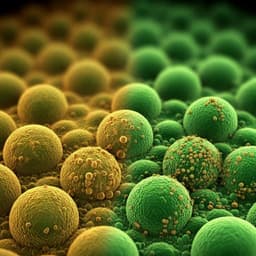
Medicine and Health
Ectopic expression of a mechanosensitive channel confers spatiotemporal resolution to ultrasound stimulations of neurons for visual restoration
S. Cadoni, C. Demené, et al.
Explore the groundbreaking research conducted by Sara Cadoni and colleagues, which reveals an innovative ultrasound-mediated activation strategy to restore vision by modulating neuronal activity with millisecond precision. This less invasive approach could revolutionize brain-machine interfaces for visual restoration.
~3 min • Beginner • English
Introduction
Brain–machine interfaces (BMIs) using multielectrode arrays have restored functions in sensory systems, including cochlear and retinal prostheses, but visual restoration is particularly demanding, requiring the rapid transmission of complex spatial patterns (~13 Hz). Optical cortical stimulation is hindered by dura and brain scattering/absorption, often necessitating invasive light guides. Ultrasound (US) could enable non-contact neuromodulation, but achieving the spatial resolution required for vision necessitates high-frequency US and typically a craniotomy. Most existing US neuromodulation uses low or mid-range frequencies, delivering poor spatial resolution (>3 mm) and long-lasting responses; very high frequencies (for example, 30 MHz) have been associated with inhibitory effects and/or require high energy with potential thermal risks. Sonogenetics offers cell-type specificity by ectopic expression of US-sensitive proteins such as TRP channels, mechanosensitive MscL, or prestin via AAV vectors, but prior implementations have lacked the spatiotemporal precision for vision restoration. The study investigates whether MscL expression can: enhance neuronal US sensitivity in vivo, selectively target neuronal subpopulations, support millisecond-precision responses, and leverage high-frequency US at low acoustic intensities to achieve fine spatial resolution without adverse effects.
Literature Review
Prior work established US neuromodulation at low frequencies for deep brain modulation, but with coarse spatial resolution and prolonged dynamics. Attempts at high-frequency US have raised concerns of inhibitory effects or excessive energy deposition with heating risk. Sonogenetics has used US-sensitive actuators (for example, TRP1, MscL, prestin) delivered by AAVs to sensitize neurons; MscL, particularly the G22S mutant, demonstrated enhanced pressure sensitivity and fast kinetics in vitro and in vivo, but without the spatial and temporal resolution necessary for visual applications. Optical methods (optogenetics) can provide higher temporal precision (>40 Hz with fast opsins) and have progressed to clinical retinal applications, but are limited by light delivery in cortex. Indirect auditory mechanisms have been shown to confound low-frequency US neuromodulation, necessitating strategies that minimize auditory pathway activation and demonstrate short-latency, spatially confined, direct neuronal activation.
Methodology
Gene delivery and constructs: AAV vectors encoded E. coli MscL either wild-type (WT) or G22S mutant, fused to tdTomato and containing a Kir2.1 ER export signal for plasma membrane localization. For retinal targeting, the SNCG promoter drove expression in retinal ganglion cells (RGCs) using AAV2.7m8 delivered intravitreally (2 µl, 8–14 × 10^10 vg). For cortical targeting (V1), the CamKII promoter (excitatory neurons) and an AAV9.7m8 vector were used; injections were made stereotactically (rats: two sites, three depths each; mice: one site, superficial depth). Expression was verified by fundus imaging and confocal immunohistochemistry (RBPMS for RGCs; NeuN for neurons; DAPI).
Ultrasound stimulation: Three focused transducers were used: 0.50 MHz (Ø 25.4 mm, focus 31.7 mm), 2.25 MHz (Ø 12.7 mm, focus 25.4 mm), and 15.00 MHz (Ø 12.7 mm, focus 25.4 mm). Stimuli had 1 kHz pulse repetition frequency, 50% duty cycle, durations 10–200 ms, and interstimulus intervals 0.01–2.0 s. Peak acoustic pressures: 0.11–0.88 MPa (0.5 MHz), 0.30–1.60 MPa (2.25 MHz), 0.20–1.27 MPa (15 MHz). Estimated Isppa: 0.39–25.14, 2.92–83.12, and 1.30–52.37 W cm^-2 for 0.5, 2.25, and 15 MHz, respectively. Acoustic fields were characterized by interferometric hydrophone measurements and simulations; focal FWHM diameters (x–y) were ~4.36 mm (0.5 MHz), 1.61 mm (2.25 MHz), and 0.276 mm (15 MHz).
Ex vivo retina recordings: Rat retinal pieces were mounted ganglion-cell-side down on 256-electrode MEAs (30 µm electrodes, 200 µm spacing). US transducers were coupled via a degassed water cone; the transducer focus was aligned using echo timing. Visual stimuli were delivered via DMD-coupled white LED. Pharmacology (CNQX, CPP, LAP4) was used to block synaptic transmission. Degenerative P23H retinas were also tested. Spike sorting used Spyking CIRCUS; analyses included ON/OFF classification, latency (SDF derivative peak), response duration (A/e criterion), Fano factor, spatial dispersion, and center-of-response displacement with transducer movements.
In vivo cortical electrophysiology: One month after AAV injections, a 5×5 mm^2 craniotomy over right V1 was performed. A 32-site µECoG array was placed on V1; for single-unit activity, a 16-site silicon probe (tilted 45°, advanced ~1.1 mm) recorded across layers. US coupling used a water-filled cone and gel; visual flashes were presented to the eye for controls. Analyses included µECoG N1 peak amplitude, response duration (A/e), activated area (thresholded pseudocolor maps), center displacement with transducer motion, single-unit latency (SDF derivative), firing rates, and responsiveness versus stimulus duration and repetition frequency.
Behavioral testing (mice): Head-fixed, water-restricted mice learned to associate full-field light stimulation (50 or 200 ms) of one eye with water reward (delivered 500 ms after stimulus). After training (days 1–4), V1 was sonogenetically stimulated at 15 MHz for 50 ms with pressures 0.2, 0.7, and 1.2 MPa (days 5 and 8–10; randomized order). Success was defined as anticipatory licking between stimulus onset and reward. Anticipatory lick rate was corrected by spontaneous lick rate and scaled by session success rate. Sessions with compulsive licking were excluded by ROUT (Q=1%).
Safety and simulations: Acoustic field simulations (k-Wave, Field II) were validated against hydrophone data. Thermal modeling (linear absorption in brain-like medium) estimated temperature rises for representative protocols (e.g., 15 MHz, up to 1.27 MPa, 10–200 ms; repetition up to 13 Hz). Regulatory acoustic intensity metrics (Isptp, Ispta) were calculated and compared to FDA 510(k) Track 3 limits for diagnostic imaging.
Key Findings
- Ex vivo retina: AAV-driven MscL expression was confined to RGCs; double-labeling with RBPMS confirmed targeting. RGCs expressing MscL responded robustly to 15 MHz US (0.98–1.27 MPa) with short latencies; a threshold of 45 ms separated short-latency (SL, likely direct) from long-latency (LL, likely synaptic) responses. Compared to non-transfected (NT) retinas, MscL retinas showed significantly more responding cells per retina (p=0.0002) and greater SL counts across pressures (p-values ≤ 0.001). G22S MscL increased the fraction of SL responders versus WT (p=0.0065 and p=0.0083). Under synaptic blockers and in degenerated P23H retinas, sonogenetic responses persisted (not observed in NT), supporting direct activation of MscL-expressing RGCs.
- Spatiotemporal control in retina: Peak firing rates scaled with stimulus duration and repetition frequency; response duration correlated with stimulus duration (R^2≈0.95). Spatial activation maps showed finer, denser activation with higher frequency US: the 15 MHz focal FWHM was 0.276 mm versus 4.36 mm at 0.5 MHz, yielding higher ratios of activated cells per stimulated area (p<0.001), and the response center translated proportionally with transducer displacement (p<0.01).
- In vivo cortex electrophysiology: G22S MscL expression in V1 produced µECoG potentials to 15 MHz US that were absent in NT animals. Single units exhibited millisecond latencies (e.g., 10 ms stimuli: 5.10 ± 0.62 ms; n=27 cells) across depths from ~100 µm to 1,000 µm. Neurons followed brief stimuli (10–50 ms) with similar firing rates; with 10 ms pulses at 1 MPa, responses could be evoked up to 13 Hz, though the number of responsive neurons decreased with frequency. µECoG N1 amplitudes scaled with pressure and duration; activated cortical area increased with pressure and shifted congruently with 0.4–0.8 mm transducer movements (displacement mean ~0.29 ± 0.16 mm for 0.4 mm commanded moves; p=1×10^-6).
- Behavior (perception surrogate): After light–reward training, G22S MscL mice responded to V1 sonogenetic stimulation with success rates comparable to light. Light success on day 4: 86.2 ± 14.1%; sonogenetic day 5: 69.3 ± 25.4% (ns). NT mice showed low success to US (38.1 ± 18.5%; significantly below their light day 4; p<0.0001). First anticipatory lick latency was shorter for US than light (187.1 ± 37.3 ms vs 265.9 ± 46.5 ms; p=2.9×10^-5). Success and anticipatory lick rates increased with US pressure in transfected mice.
- Safety and energy deposition: Typical parameters (e.g., 10 ms, 0.6 MPa) yielded Isptp ≈ 12 W cm^-2 and Ispta ≈ 0.12 W cm^-2, within FDA diagnostic imaging limits. Thermal simulations for 15 MHz, up to 1.27 MPa, predicted small local temperature rises (~0.12 °C for 20 ms at 1.27 MPa; <0.30 °C at 13 Hz repetition), indicating minimal heating. Acoustic intensities remained far below those causing tissue damage and below levels used without damage in recent high-frequency safety studies (e.g., continuous 11.8 W cm^-2).
Overall, high-frequency sonogenetics with MscL enabled millisecond-latency, spatially confined activation compatible with visual restoration requirements and produced behavioral evidence of perception.
Discussion
The study addresses a central challenge in BMIs for vision: delivering patterned neuronal activation with millisecond timing and sub-millimetric spatial precision while minimizing invasiveness and energy deposition. By combining targeted expression of the mechanosensitive channel MscL (notably the G22S mutant) with high-frequency US (15 MHz), the authors achieved direct, short-latency activation of retinal and cortical neurons at pressures/intensities within clinical safety regimes. Ex vivo and in vivo electrophysiology demonstrated that responses were spatially confined (≈0.3 mm focal width at 15 MHz), time-locked to stimuli with few-millisecond latency, and scalable with stimulus parameters, enabling up to 13 Hz presentation rates. Pharmacology and degenerated retina experiments support direct mechanotransduction via MscL rather than indirect synaptic or auditory mechanisms. In vivo, the precise displacement of cortical activation with transducer movement and the pressure-dependent expansion of activated area further indicate controllable spatial targeting. Behaviorally, cortical sonogenetic stimulation elicited lick responses consistent with perceived visual events in trained mice, with performance comparable to light stimulation in transfected animals and significantly above NT controls. While the temporal bandwidth (≈13 Hz) is below that of the fastest optogenetic actuators, it falls within the lower bound thought sufficient for basic vision. The approach suggests a path toward less invasive cortical visual prosthetics using cranial windows and US matrix arrays, potentially avoiding penetrating electrodes and complex optical hardware, while preserving cell-type specificity via gene delivery.
Conclusion
This work demonstrates that ectopic expression of the mechanosensitive channel MscL, combined with high-frequency (15 MHz) ultrasound, enables millisecond-latency and sub-millimetric, steerable neuronal activation at acoustic intensities compliant with safety standards. The method robustly activates targeted retinal and cortical neurons, generalizes across depths in V1, and produces behavioral evidence of light-like perception in mice. It offers a promising, less invasive alternative to electrode-based cortical BMIs for vision restoration and complements optogenetic approaches by eliminating the need for intracranial light delivery. Future research should optimize actuator variants to enhance sensitivity and temporal bandwidth, engineer implantable high-frequency US matrix arrays compatible with cranial windows for patterned stimulation, rigorously evaluate long-term safety and gene therapy durability, develop closed-loop strategies integrating sensory encoding models, and extend behavioral testing to complex visual discrimination tasks to quantify functional restoration.
Limitations
- Temporal bandwidth: In vivo following of repetitive stimuli was demonstrated up to ~13 Hz, which is lower than the performance of fast opsins (>40 Hz) and may limit fidelity for some visual functions.
- Invasiveness: Although less invasive than penetrating electrode arrays, current implementation requires a craniotomy and cranial window for high-frequency US transmission.
- Gene therapy considerations: Efficacy depends on targeted AAV expression in specific neuronal populations; variability in transduction, expression levels, and long-term stability in non-dividing neurons warrant further evaluation.
- Generalizability and behavioral scope: Behavioral evidence indicates perceived events, but more complex visual tasks (e.g., form discrimination) are needed to establish the richness and spatial acuity of the percept.
- Potential confounds: While short latencies and high-frequency stimulation argue against indirect auditory mechanisms, comprehensive controls across species and parameter spaces are necessary.
- Thermal and mechanical safety margins: Simulations predict minimal heating under tested conditions, but chronic, high-duty-cycle use and translation to human skulls/dura require additional safety validation.
Related Publications
Explore these studies to deepen your understanding of the subject.







